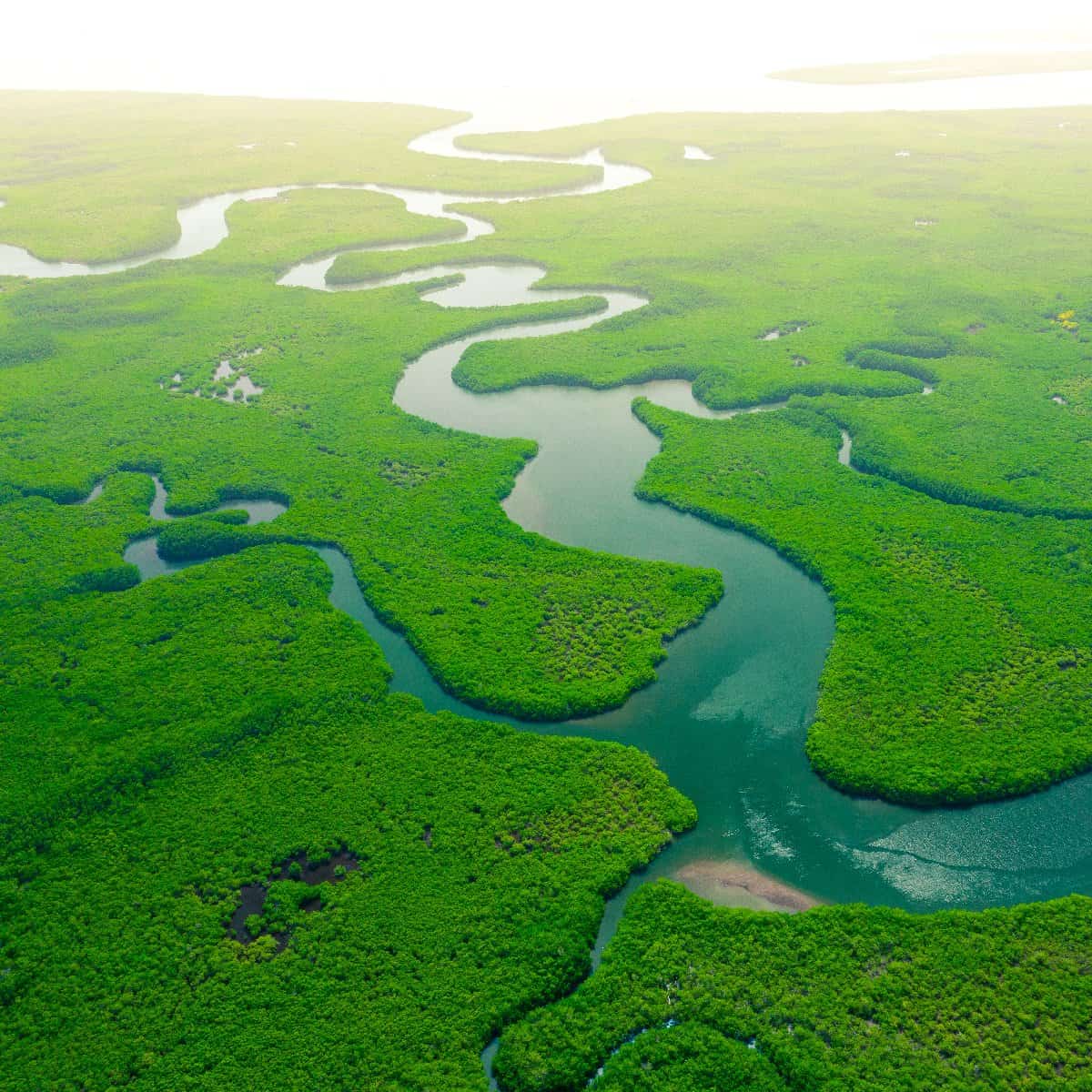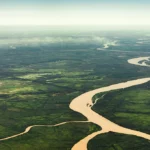Embark on a watery journey of discovery as we unveil the secrets of the widest river in the world. The question seems simple, but defining “widest” proves surprisingly complex.
Defining River Width
Pinpointing the widest river is like measuring a living, breathing entity. Rivers constantly change, influenced by seasons, tides, and surrounding terrain. Defining “widest” involves considering various factors:
- Widest Point: The single greatest breadth across the river.
- Average Width: The typical width along the river’s course.
- Estuary Width: The measurement where the river meets the sea, which can be significantly larger due to the mixing of fresh and saltwater.
Rainfall, snowmelt, and tides all contribute to a river’s dynamic dimensions. The Amazon, for example, may swell to an astounding 24 miles across during the rainy season—wider than some countries are long! This fluctuation makes defining a single “widest” measurement a challenge.
The Contenders
Several rivers vie for the title of “widest,” each with its own unique characteristics:
The Amazon River
The Amazon, often cited as the widest, holds the Guinness World Record for the widest river. Even in the dry season, it stretches an impressive seven miles across. During the rainy season, this expands to approximately 25 miles, a nearly fourfold increase. However, some experts question whether the Amazon’s entire rainy-season breadth should be considered, as the extreme edges may include flooded plains rather than the main river channel.
The Río de la Plata
The Río de la Plata, formed by the confluence of the Paraná and Uruguay rivers, presents a compelling alternative. Its estuary spans a staggering 137 miles at its widest point. However, whether an estuary should be considered part of a river remains a point of contention. Some argue that a river’s width should be measured within its distinct banks, excluding the merging waters of an estuary. This ambiguity complicates the “widest river” debate.
Other Notable Rivers
Other rivers, while not as expansive as the Amazon or Río de la Plata, deserve recognition for their impressive widths:
- Brahmaputra River (Asia): Reaches over four miles wide in certain sections.
- Congo River (Africa): Known for its significant breadth, though precise measurements vary.
- Ob River (Russia): Reaches impressive widths, especially during seasonal high water.
- Lena River (Russia): Another Siberian giant with a substantial width.
- Yangtze River (Asia): One of the longest rivers in the world, also boasting notable width.
- Mekong River (Southeast Asia): A vital waterway with considerable width in certain areas.
- Ganges River (Asia): Known for its cultural and ecological importance, and significant width.
- Indus River (Asia): A major river system with varying widths along its course.
- Darling River (Australia): Though not a contender for the widest, still boasts significant stretches of impressive breadth.
- Huang He (Yellow River) (Asia): Historically and geographically important, the Yellow River also possesses considerable width.
- Missouri River (North America): Known for its length, the Missouri is also remarkably wide at points.
The Significance of River Width
River width is more than just a measurement; it has profound implications:
- Navigation and Trade: Wider rivers facilitate the transport of goods and people, connecting communities and supporting economies.
- Ecosystem Health: River width influences habitat diversity and the overall health of aquatic ecosystems.
- Flood Management: Understanding river width is crucial for predicting and mitigating flood risks.
Beyond Width: Discharge Volume
While width is a key characteristic, discharge volume—the amount of water flowing through a river—offers another important perspective. The Amazon, once again, leads, discharging a tremendous volume of water into the ocean, influencing global currents and weather patterns. Discharge volume, like a river’s pulse, reveals its vital role in the planet’s hydrological health.
The Ever-Changing Nature of Rivers
Rivers are dynamic systems, constantly responding to natural forces. Seasonal changes, tides, and geological processes influence their widths. Ongoing research explores how these factors, along with human activities and climate change, impact river dynamics. This evolving understanding helps us better predict and adapt to the ever-changing nature of these vital waterways.
Where is the Widest River in the World?
Determining the location of the world’s widest river depends on how “widest” is defined. Is it the average width, the single widest point, or the expansive mouth where the river meets the sea (an estuary)?
The Amazon’s Claim
The Amazon, located in South America, flowing through multiple countries including Brazil and Peru, often claims the title. It holds the Guinness World Record for the widest river, measuring seven miles across even during the dry season. This expands to an incredible 25 miles during the rainy season.
The Río de la Plata’s Challenge
The Río de la Plata, between Uruguay and Argentina, presents a strong counter-argument. At its widest point, the estuary stretches an astounding 137 miles. This vast expanse raises the question: should an estuary be considered part of a river? Some experts believe the measurement should be confined to the river’s distinct channel, excluding the merging waters of an estuary.
Other Wide Waterways
Other rivers worldwide, such as the Brahmaputra in Asia, contribute to the “widest” discussion. The Brahmaputra can exceed four miles in width at various locations, demonstrating the significant scale of these natural formations.
A Matter of Perspective
Ultimately, pinpointing the single widest river depends on the definition used. The Amazon boasts the widest single channel of flowing river water, especially during the rainy season. However, if estuaries are included, the Río de la Plata’s immense width surpasses all others.
Is the Amazon the Widest River in the World?
The Amazon River, a South American giant, often receives the “widest” accolade. But the reality is more nuanced. During the dry season, it reaches an impressive seven miles wide—a measurement recognized by Guinness World Records.
Seasonal Changes
The Amazon’s width fluctuates dramatically with seasonal rainfall. During the wet season, it swells considerably, potentially reaching 25 miles across. The exact measurement remains challenging to determine precisely due to the dynamic nature of flooding.
The Río de la Plata
The Río de la Plata, formed where the Paraná and Uruguay rivers meet the Atlantic Ocean, complicates the “widest” discussion. Its estuary, a zone where freshwater mixes with saltwater, stretches an incredible 137 miles. The question arises: is an estuary part of a river, or a distinct entity? Some argue for excluding estuaries from width measurements, while others maintain their importance.
Defining “Widest”
The lack of a universally accepted definition for “widest river” fuels the ongoing debate. Should it be the average width, the single widest point, or the estuary width? Depending on the metric, the “widest” title could shift between the Amazon and the Río de la Plata.
Comparison Table
| Feature | Amazon River | Río de la Plata |
|---|---|---|
| Widest Point (Dry) | 7 miles | Varies, up to 137 miles at the estuary |
| Type | River | Estuary (where rivers meet the ocean) |
| Discharge Volume | Largest in the world | Significant, but less than the Amazon |
| Length | One of the longest (competes with the Nile) | Relatively short, primarily an estuary |
The Amazon’s Other Superlatives
Even if the “widest” title remains contested, the Amazon’s other impressive attributes are undeniable. It carries the largest discharge volume globally, exceeding the combined flow of the next seven largest rivers. It also competes with the Nile for the title of longest river.
The Future of River Width
The dynamic nature of rivers, influenced by factors like climate change, adds further complexity. Rising sea levels and changing rainfall patterns could dramatically alter river systems, challenging our current understanding of their width and impacting the “widest river” debate.
What is the Widest River in the US?
While the global “widest river” debate centers on the Amazon and Río de la Plata, the US boasts its own impressive waterways. The Mississippi River often takes the title, reaching an astounding 11 miles across near Lake Winnibigoshish in Minnesota.
The Mississippi’s Varying Width
The Mississippi’s width varies considerably along its 2,320-mile journey through ten states. Its average width is approximately 1.2 miles. At Lake Pepin, bordering Wisconsin and Minnesota, it averages two miles wide.
The Missouri River
The Missouri River, the longest river in North America at 2,341 miles, also commands attention for its width. At certain points, it exceeds 10 miles across, making it a strong contender for the “widest” title within the US. It eventually merges with the Mississippi near St. Louis.
Defining “Widest” in the US
Defining “widest” within the US also presents challenges. Is it the maximum width, the average width, or the total volume of water carried? Each metric yields different results, showcasing the diversity and complexity of US river systems.
Comparison Table
| River | Maximum Width (approx.) | Average Width (approx.) | Length (approx.) |
|---|---|---|---|
| Mississippi | 11 miles | 1.2 miles | 2,320 miles |
| Missouri | 10 miles | Varies | 2,341 miles |
| Yukon | 3 miles | Varies | 1,980 miles |
| Colorado | Varies | Considerably less | 1,450 miles |
Other Notable Rivers
Other US rivers, like the Yukon in Alaska, which reaches over three miles wide in some places, and the Rio Grande, also contribute to the discussion of impressive widths.
The Dynamic Nature of Rivers
River widths are not static. They fluctuate with seasonal changes, rainfall, and snowmelt, adding further layers to the “widest” discussion. Ongoing research continues to refine our understanding of these dynamic waterways. These fluctuations highlight the ongoing change and adaptation within these vital natural systems.
- China II Review: Delicious Food & Speedy Service - April 17, 2025
- Understand Virginia’s Flag: History & Debate - April 17, 2025
- Explore Long Island’s Map: Unique Regions & Insights - April 17, 2025
















